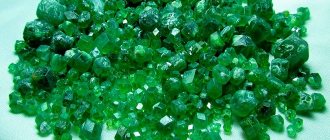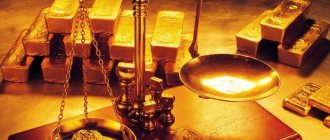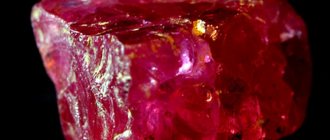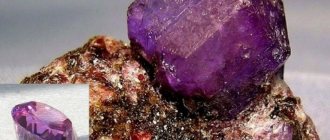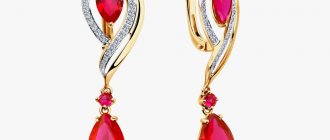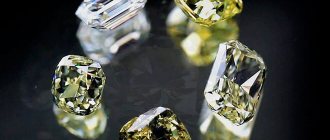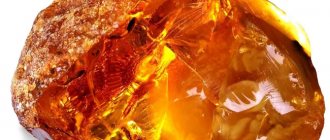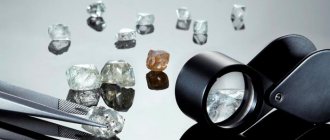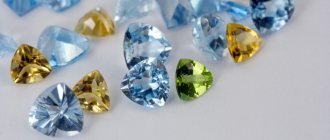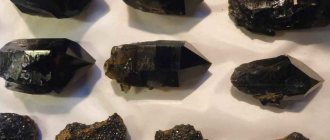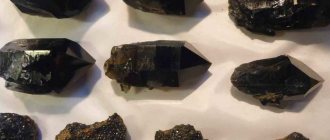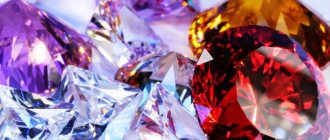Ophite? - a representative of the serpentine (coil) group. The name of this jewelry and ornamental stone comes from the Greek word “office”, meaning “snake”. The translucent mineral, which is hydrous magnesium silicate, has a dense fibrous structure and is distinguished by a beautiful golden-olive hue.
Mineral – Ophite
History and origin
Serpentine is found in different countries. Everywhere the mineral is associated with snakes, and legends are made about it:
- Southern Europeans believe that ophite is fossilized snake venom,
- among the Mongols, the gem is the personification of a snake-like creature named Olgoi-Khorkhoi, who turns to stone at the moment of danger,
- according to a belief widespread in Asia Minor, the serpentine is a piece of apple that Adam choked on,
- Russian legends contain information that the gem is formed from the skin shed by the fabulous snake the Great Snake, left in the mountains.
Reference! Ophyte is characterized by hydrothermal-metasomatic origin, partly hypergene.
Place of Birth
There are deposits of this gem on every continent. The mineral is mined in:
- Russia (in the Urals, Siberia);
- Georgia (in the North Caucasus);
- Kazakhstan;
- Switzerland;
- USA;
- Sweden;
- Italy.
Attention! The largest deposit is located in the Ural Mountains.
Physico-chemical properties of stone
| Properties | Description |
| Formula | X2-3Si2O5(OH)4 |
| Impurity | Hornblende, Augite. |
| Hardness | 2,5 — 4 |
| Shine | Glassy, greasy, waxy. |
| Kink | Conchoidal. |
| Density | 2.2 - 2.9 g/cm³ |
| Transparency | Translucent around the edges, opaque. |
| Color | Dark to light green, yellowish green. |
Varieties and colors
The serpentine group consists of several minerals. We are talking about magnesium hydrosilicates with the same composition, but different structure. In addition to ophite, coils are represented by antigorite, chrysotile, and lizardite. In the serpentine group you can also see hydrous nickel silicates like garnierite.
Ophite is called noble serpentine. In nature it looks like dense opal-like secretions. The mineral is translucent, unlike other varieties of serpentine. Able to partially transmit sunlight. The mineral is fragile, characterized by a waxy luster, and may appear greasy to the touch. The structure of the ornamental stone is dense and uniform.
Pendant
Depending on the color scheme, ophite comes in the following varieties:
- whitish-green;
- yellow-green with a golden tint.
Also read: Fluorite - a stone that glows in the dark and under ultraviolet light
Serpentine with a mottled color (gray with black spots or gold sparkles), reminiscent of a snakeskin pattern, is called mossy.
A harder type of serpentine, visually reminiscent of jade, is called bowenite. The softer one, which contains black octahedral inclusions, is called Williamsite.
What does a gem look like?
Unlike the classic spotted serpentine, the color of the opite is light, uniformly green or with a yellowish tint, without dark stripes or inclusions.
Ophite is dense, slightly translucent, and has a silky sheen. These qualities bring it closer to noble jade. Although jade is almost twice as hard.
Ophite is one of two noble varieties of serpentine (coil in Russian).
Its name is also associated with this reptile: in Greek, “office” is a snake. Appears in literature as noble serpentine. For businessmen or investors, this is an option.
Areas of application
Ophite is a beautiful mineral that can be easily processed. It is a jewelry and semi-precious stone. Used in jewelry. Used to create bowls, figurines, boxes.
Low-quality serpentine is used in the design of residential premises (wall cladding, decorative elements), in landscape design (paths are laid out of untreated stones, unusual compositions are created).
The coil is applicable in industry:
- for internal lining of furnaces;
- to obtain fire-resistant material from which protective clothing is made.
Classification of gemstones
At the same time, the stone must be wear-resistant, resistant to fading and exposure to moderately aggressive environments. Such stones are high-quality raw materials and are mainly used for cutting.
Ornamental stones include some transparent, translucent, translucent and opaque crystals, mineral aggregates, rock masses and other stone formations with various inclusions and various patterns.
Ornamental stones are used both in jewelry and for the production of carved items. These can be figurines of different shapes and sizes, figurines, vases, busts, massive decorative elements for facades and interior decoration of residential premises, etc...
Determining the value of an ornamental stone is spontaneous in nature, sometimes without clear boundaries. It is clear that it should cost an order of magnitude lower than precious stones. But let's take jadeite or jade as an example! High-quality beads made of bright green jade, with a uniform color and rare dark spots, can cost tens of thousands of dollars.
Well, how can such a stone be called ornamental after this?! Or a cabochon of translucent jadeite with an even grass-green color costing from $500 per carat?! How do you like this ornamental stone?
Hence the conclusion - all stones can be divided into groups and according to significance. But in no case should you determine cost or value based solely on the group in which the mineral is located. IMHO.
There are many classifications of precious stones. Each has a common underlying principle. But there are also differences. The construction of mineral orders is influenced by various factors: fashion trends for a particular stone, demand, development of old deposits, or the discovery of new ones, etc...
Below is the most common classification of precious stones, which is already 30 years old, and has been successfully used in Russia and the former USSR among amateurs and professionals.
Medicinal properties
Representatives of the serpentine group have the ability to absorb negative energy and promote healing in various diseases.
Lithotherapists recommend using ophite:
- in the treatment of sexual disorders;
- to relieve headaches;
- for fractures;
- to recover from a coma;
- to stabilize blood pressure in hypertension;
- for colds and inflammatory processes in the body;
- for neuroses;
- from insomnia;
- in the treatment of gastrointestinal and kidney diseases;
- to enhance the effect of medications.
To preserve the power of the healing mineral and cleanse it of negativity, it is recommended to hold the stone under running water for 20-30 minutes once a day.
Magic properties
Ophit does not change the personal qualities of the owner, but can exacerbate existing internal contradictions.
The 23rd day of the lunar calendar is suitable for activating the magical properties of the gem.
This mineral is considered the devil's stone. It is used in black magic rituals. For an ordinary person, regular wearing of a coil is not recommended due to the powerful magical powers contained in the gem.
The mineral is closely related to the owner. It has the ability to warn of impending diseases. In such cases, the owner feels a burning sensation at the point of contact of the stone with the skin.
Also read: Sodalite - a stone of intuition and supernatural abilities
Ophit cannot be given or transferred. According to the sign, such a gift is not good.
Stone cost
Serpentine, including opite, is an inexpensive ornamental stone. The low cost is due to the quality of the mineral, its wide distribution and easy extraction process.
In the Russian Federation, ophyte is purchased at a price of 5 to 10 US dollars per 1 kg. The cost of a block of coil for wall cladding will range from $350 to $500.
Jewelry made from tumbled ophite fragments (earrings, brooches, pendants, bracelets) is also inexpensive. Their average price is $15.
Semiprecious stones
The list of semi-precious stones includes jewelry that is used for decorations and applied crafts. The following criteria indicate the high quality of semi-precious stones:
- transparency;
- bright and clean color;
- absence of cracks and foreign inclusions;
- attractive pattern;
- mineral size.
In the modern jewelry industry, about a hundred types of such minerals are used. The value of all stones depends on the following factors:
- rare in nature;
- decorative and artistic characteristics;
- fashion trends;
- strength, which affects the durability parameters of gems.
Today, it is not recommended to call jewelry stones semiprecious. This term is considered obsolete by gemologists. However, it is often used in trade and is even recorded in legal papers.
At first, semi-precious stones were called stones that, according to some criteria, did not meet precious ones. They could be inferior in appearance, strength and, as a result, price.
Today such a term is considered incorrect. The fact is that the prefix “semi-” seems to discredit the jewelry in the eyes of buyers, hinting at its inferiority and cheap price.
Precious and semi-precious minerals may have different values, and the latter may command a higher price than the former. Therefore, today such products are recommended to be called jewelry stones.
In accordance with the classification of E.Ya. Kievlenko, the second order of the first group includes sapphires of unusual colors, alexandrites, black opals and jadeites. Alexandrite is a chrysoberyl that can change color depending on the light. In natural light it appears green, and in artificial light it appears red-violet. This characteristic is associated with the presence of trivalent chromium particles in the composition.
Opals are silica hydrogels. This means that they are amorphous quartz, the structure of which contains up to 10% water. The noble black opal has the maximum value. Its surface is decorated with rainbow tints. As a rule, opals are not cut. They are shaped into cabochons.
White and fire opals belong to the third order. Also included in this category are aquamarines. Spinel and chrysolite belong to this group. In addition, this category includes red tourmaline rubellite and other stones and minerals.
Topaz also belongs to this group. It is an aluminum silicate containing fluorine. Topazes can have yellow, golden, pink shades. Minerals that have pronounced opalescence look beautiful. The stones have a bright shine and can easily withstand various types of processing, including grinding. According to the Mohs scale, their hardness is 8 points.
Order IV includes different types of tourmaline. It can be polychrome or pink. Blue and green species belong to this category. Also in the group of minerals belonging to this order are natural stones such as garnet, orange zircon, citrine, and amethyst.
Today there are many varieties of jewelry and ornamental minerals. Below are the stones in alphabetical order:
- beryl – this category includes morganite, chrysoberyl, aquamarine;
- garnets - there are such types as tsavorite, pyrope, rhodolite, demantoid;
- quartz – the group includes citrine, rauchtopaz, amethyst, prasiolite;
- opal;
- taaffeit;
- tanzanite;
- topaz;
- tourmaline - these include verdelite, paraiba, indigolite;
- chrysolite - such stones include olivine and peridot;
- zircon;
- spinel;
- euclase
Caring for your jewelry
Serpentine requires special care. The mineral is cleaned using warm soapy water. Contaminants are removed by wiping the surface of the stone with a soft cloth soaked in it. Abrasive compounds are not applicable for cleaning the ophite.
Jewelry from Ofite
To preserve the attractive appearance of jewelry with a mineral, it is removed before visiting the gym. Contact of ophite with household chemicals is unacceptable.
Important! Store the mineral separately from other jewelry. It is soft and easily damaged.
How to wear
Jewelry containing ophite cannot be worn on the body all the time. Magicians recommend wearing them no more than 2-3 times a week . The stone has the strongest energy and absorbs the negativity of the owner and the people around him. It is required to periodically clean it energetically with running water. It will take away the negativity accumulated in the mineral.
Reference! Decoration with ophite for medicinal purposes is chosen taking into account the disease that is bothering you. For headaches, it is advisable to wear earrings with serpentine, for colds and throat diseases - beads or a neck pendant, and for a broken arm - a bracelet. Storing medicines in an ophyte box will enhance their healing properties.
Popular colors
- The most popular representatives of the green group are malachite, emerald, aquamarine, peridot and jade. They go well with the image of a young, sophisticated lady and are suitable for those with snow-white skin and bright, light eyes. Sea aquamarine has a special, enchanting energy, and the famous emerald gives its owner a special mystery.
- Rich red shades emphasize the passion, stunning and explosive nature of the hostess. Bright rubies, interesting garnets and delicate rubellites are often framed in yellow gold. They are suitable for respectable, self-confident, successful women in the prime of their lives.
- Yellow and orange stones are best for everyday use. Inexpensive amber and classic topaz are often paired with 925 sterling silver to create contrast. Their large sizes look good on women's rings and original necklaces, but such minerals are rarely used for earrings due to their heavy weight.
- In the light of the evening spotlights, blue-blue and violet varieties of precious stones shimmer amazingly. Charming sapphires, breathtaking topazes and dark amethysts look great on large pendants and iridescent bracelets.
Compatibility with zodiac signs
(“+++” – the stone fits perfectly, “+” – can be worn, “-” – is strictly contraindicated):
| Zodiac sign | Compatibility |
| Aries | + |
| Taurus | + |
| Twins | + |
| Cancer | — |
| a lion | + |
| Virgo | +++ |
| Scales | + |
| Scorpion | + |
| Sagittarius | + |
| Capricorn | +++ |
| Aquarius | + |
| Fish | — |
The gem has the energy of Pluto and Mercury. Astrologers advise Virgos and Capricorns to wear the ophit. For the first ones, the talisman will relieve apathy and inspire them to gain new knowledge. For the latter, many of whom are workaholics, it will help them relax.
The mineral is contraindicated for Pisces and Cancers due to the increased risk of a nervous breakdown from contact with this energetically powerful stone.
Other representatives of the zodiac circle can sometimes decorate themselves with jewelry with serpentine. They won't do any harm.
Is this stone right for you?
BLACK STONES IN JEWELRY
Anthracite gray stones are often framed in silver. This makes jewelry cheap, in the range of 5-7 thousand. However, platinum is often used instead of silver, with which any jewelry becomes much more prestigious.
- A ring with a dark stone framed in platinum will look great on the hand of any leader or businessman.
- A men's signet ring with engraving and inlaid with a black stone looks solid. With its brilliance it attracts the attention of others.
- Although jewelers rarely work with these minerals due to their low strength, this does not mean that their beauty is inferior to other, lighter stones.
In some cases, dark inserts are used in belts; they are suitable for girls to emphasize their figure.
In silver and gold jewelry, black stones look stylish and sophisticated. The main thing is to choose the right clothes and play on the contrast of colors.
Interesting things about the stone
Ophite talismans (figurines, decorative elements) have protective properties. They will protect housing and household members from troubles, fire, and theft.
Wearing a coil on the body sharpens intuition. The stone is recommended as a talisman for lawyers and businessmen. It will promote good luck in business.
Pharmacists use ophite utensils in the process of preparing medicines to enhance the therapeutic effect they provide.
Ophite is a beautiful inexpensive mineral used to create jewelry, decorative elements, and used in landscape design. The gem has healing properties and the ability to absorb negativity. It will be an excellent purchase for a person who dreams of improving his health and protecting his home from harm.
5 / 5 ( 2 voices)
Third group: ornamental stones
Jasper, written granite, petrified wood, marble onyx, obsidian, jet, jaspilite, selenite, fluorite, aventurine quartzite, colored marble.
Ornamental stones are used mainly for the manufacture of massive stone-cutting products, the size of which amounts to tens of centimeters and more.
